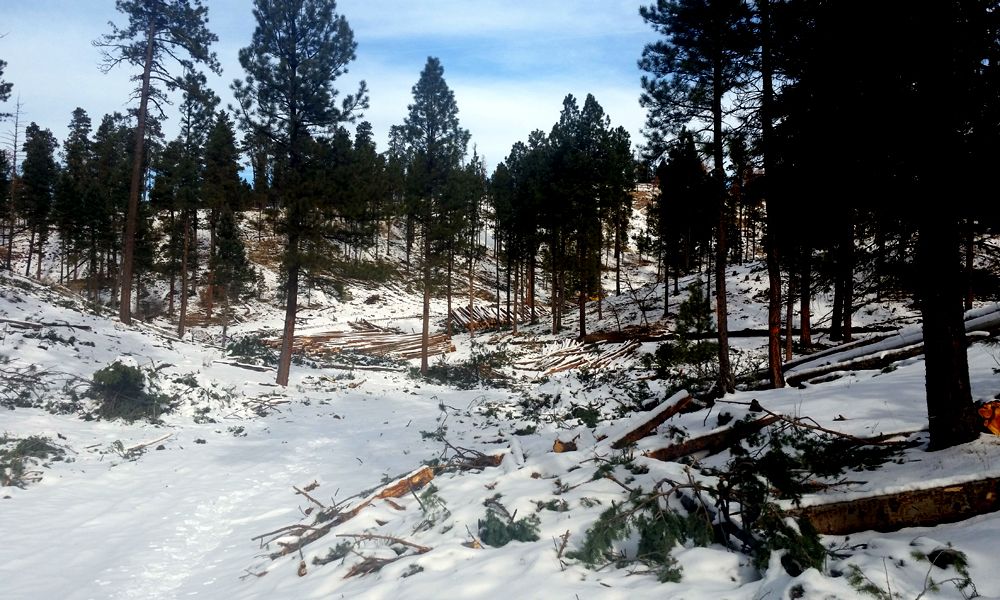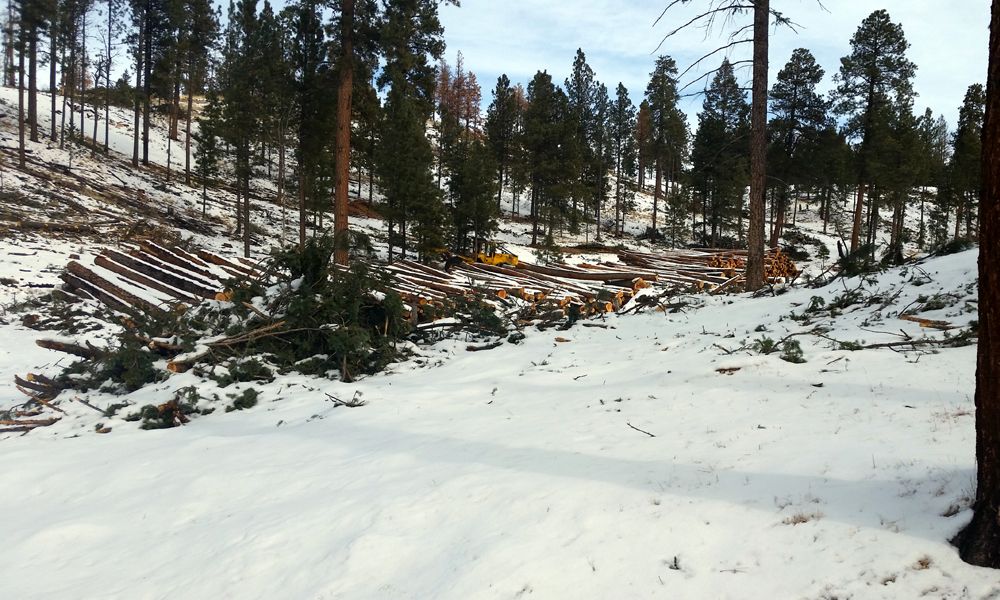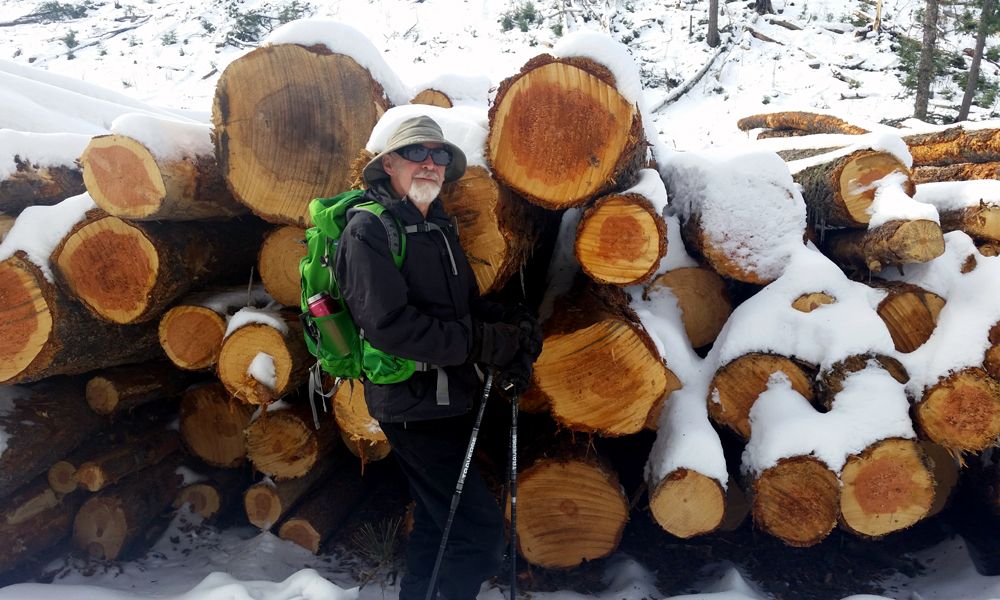|
| Author |
Message |
MtnDon
Member
|
# Posted: 7 Jan 2017 11:16am
Reply
Like much of the western mountains, the Jemez Mountains of New Mexico have suffered from decades of wildfire suppression and the cessation of commercial logging. However, after years of planning and studies we now have a serious thinning effort underway in the mountains around our property. (We are one of 4 or 5 private landowners who ar surrounded by the Santa fe National Forest. We've thinned our land, most of the neighbors have not... but that is another matter.)
Here are a few pictures we took between Christmas and New Years.
This is an area very close to us. Before the thinning we could not see the slope in the distance. It was a wall of green pines.

A closer in shot of the central area from the first image. Taken closer and looking to the right down the road that runs up the draw.

Yours truly standing in front of one of the numerous stacks of logs, showing typical range of sizes harvested.

In some places even larger trees have been harvested as well as the smallest and everything in between. The present active contract is for approximately 1200 acres. One day while we were tramping around the woods on our snowshoes we cameacross the forest service fuels specialist. We chatted a while. The project is aimed at reducing the tree density down to 20 to 60 trees per acre, average. That is from a high in many places of 900 to 1000 trees per acre.
Unfortunately there is not a big market for the harvested trees. Mostly the larger trees will become large size posts and beams for custom homes. NM also uses a number of peeled round logs in many custom homes... in the manner that all homes here used to be built. However, when it comes to 2x lumber it is difficult to compete on price with Canadian imports and plantation lumber from the Southern USA. So much of the harvest will end up being gathered for firewood in spring and summer. Once the logs are removed and the slash dry then those piles will be burned next winter.
Then we will see the native grasses regrow. We've already seen more deer than in previous years, all because of the greater visibility through the trees. It is also so cool to be able to see the lay of the land, to be able to seethe slopes and details in the distance. We are thrilled to see the work that has been done so far. This should go a long ways to improve the general health of the forest here.
|
|
bldginsp
Member
|
# Posted: 7 Jan 2017 07:04pm
Reply
Congratulations Don on a successful thinning operation. You'll rest a lot easier when the inevitable occurs, and the forest will recover faster.
Wish I could report similar success in the Northern Sierra of California. An effort was made to compromise between environmentalists on the one side and logging interests on the other. Many enviros (pardon the abbreviation) want to see not a twig cut and "let nature take its course" meaning let the fires rip. They write articles about how the fire is natural and how the forest recovers. But foresters say that the brush buildup is too high from fire suppression, which is an unnatural condition, so when fires come through there is so much fuel that the fire becomes far more severe than in the past, and kills everything.
On the other side, the logging interests say they want to go in and thin the forests, but in order to pay for it they want to take out a percentage of larger trees. The smaller trees aren't worth enough to pay the cost of the operation. So if no larger trees are taken, government money must make up the difference. The locals don't want to be dependent upon government subsidies, they want to make a living without that.
So the compromise they reached was that logging would be allowed with certain limitations, closely watched by the foresters supervising the logging plans. A special lumber mill was constructed with machines designed specifically to maximize lumber output from smaller trees.
But then the enviros continued to stop logging plans with EIR suits etc. The special lumber mill was shut down for lack of logs.
The last few fires in the area have left large areas with all trees dead as the un-thinned forest burns in an unnatural manner. Ironically, the lumber industry benefits from this as the loggers are able to go into the burn areas and cut the dead trees.
Several fires over the last few years have left some residential areas with many burned homes. Yet, where I am, there is not a concerted effort to do the thinning needed in residential areas, the WUI as it's called. Not for lack of trying, there are Fire Safe Councils in all the counties trying to arrange as many thinning projects as they can given available funding. But the public isn't pushing for it, and there are plenty of at-risk WUI areas that will suffer when the inevitable occurs. Just human nature I suppose.
|
|
MtnDon
Member
|
# Posted: 7 Jan 2017 10:17pm
Reply
Quoting: bldginsp "let nature take its course" meaning let the fires rip. They write articles about how the fire is natural and how the forest recovers.
We have an organized group here that also promotes leaving the forests as they are. Part of their argument is that tree cutting is bad because trees absorb CO2 and thinning and burning slash uses fuel for the machines and the slash burning produces CO2. They are so short sighted.
Up until the late 1880's our neck of the woods had natural fires. Every 7 to 11 years an area would be burnt; needle duff would get burned, as would small trees and shrubs, grasses. The larger trees would survive those fires. With the railroads came people and with people cattle. Cattle ate the grasses so short there was nothing to burn. With no grasses to burn many small trees took root. It seems the natural long grasses (uneaten by cattle) prevent the ponderosa pine seeds from germinating. No grass = hundreds if not thousands of pine seedlings per acre. I've seen 10 x 10 foot areas with over a hundred young pines. After ten years unchecked nothing can move through that area. About the same time lumber interests campaigned for any and all wildfires to be put out to preserve the timber. It's been downhill since.
|
|
MtnDon
Member
|
# Posted: 7 Jan 2017 10:24pm
Reply
Addendum: We had a huge fire in 2011, the Los Conchas fire. It was explosive, burning an acre a second. Per second, not per minute. The first days burn calculated to 1.17 acres per second to be more precise. It roared through the trees, ground level to tree tops. However, when it hit the areas burned in the Cerro Grande fire (2000) and the Dome Fire (1996), the fire dropped to the ground. That is how natural fires acted 100+ years ago.
|
|
TerraLove
Member
|
# Posted: 9 Jan 2017 05:00pm
Reply
CO2 is plant food, we are currently at the very low levels, dangerously low. And if the temperatures keep swinging the way they used to for the last 350,000 years, we may be on the verge of at least a 1000 year long very sharp 10 degree F decline. If that happens (and no one knows one way or another), humankind is SOL.
|
|
Julie2Oregon
Member
|
# Posted: 9 Jan 2017 05:33pm
Reply
What kind of trees are those?
I need to have a few older 100 or so footers plus some others taken down on my land. They don't look diseased but they're getting crowded out on inclines and they're all competing for soil nutrients over volcanic rock.
I've located a local forest products business that saws and sells boards from their own and local timber. I plan to give them a call in the spring. They won't take down the trees but they would pay me for the logs and pick them up. Or they'll bring equipment to saw them into boards I can use for my place. I may want to do a bit of both. Use some, sell some.
Have y'all searched for smaller timber products businesses in your area? Don't count out all of the "environmentalists." Some recognize the need for responsible forest management and like to use area timber.
|
|
silverwaterlady
Member
|
# Posted: 9 Jan 2017 06:22pm
Reply
Not sure how wet your ground will be in the spring.
Speaking from experience I would not allow any heavy equipment or skidders on my land in the spring.
This is why they do logging when there is snow on the ground. So they don't tear up your ground.
And they are not nice and kind about cutting either.
I've seen the aftermath of some property's including mine (off road in the bush but still heartbreaking and done because we did not have the money to pay our taxes) and it's not pretty.
|
|
Julie2Oregon
Member
|
# Posted: 9 Jan 2017 06:36pm
Reply
silverwaterlady
Oh, very good points, thanks! I'm still in winter-mode thinking and haven't even thought about what happens when all of this white stuff melts! So, late winter will be the time, then, before the thaw? With the constant parade of storms, finding a time when they can get the equipment out here will be interesting!
|
|
|
silverwaterlady
Member
|
# Posted: 9 Jan 2017 06:49pm
Reply
IDK when they cut up there, just wanted to give you a heads up.
|
|
MtnDon
Member
|
# Posted: 9 Jan 2017 07:06pm
Reply
Quoting: Julie2Oregon What kind of trees are those?
The forest is predominantly Ponderosa Pine. There is some Douglas Fir, White Pine and Aspen as well as Gambel Oak. The Ponderosa's grow like weeds.
Here they cut in winter and summer/fall after the monsoons have passed.
|
|
old243
Member
|
# Posted: 10 Jan 2017 09:27am
Reply
In our area most of the logging is done in the winter , so loggers can freeze the haul roads , If you are concerned about damage, there is some horse logging , still being done in our area, This might work if it is a smaller job. Check the local papers, some of the Mennonite community , in our area use smaller equipment as well. A bush beside me was thinned several years ago, with hand felling, skidding done using bobcats. Very little damage. It is growing back nicely. This is hardwood bush , maple, beech, cherry. old 243
|
|
silverwaterlady
Member
|
# Posted: 10 Jan 2017 08:57pm
Reply
Julie, Forgot to mention that after the labor involved in the cutting you won't get enough money unless you have at least twenty acres to clear cut.
Maybe they will do selective cutting but how can they make money doing that? The equipment most of them use costs a lot and they need to have a certain profit margin.
They might take a look at it and tell you to hire somebody to cut the trees down.
|
|
MtnDon
Member
|
# Posted: 10 Jan 2017 10:47pm
Reply
I neglected to mention in my OP that the forest service is paying an average of $550 per acre on this thinning contract. That is for cutting, stacking in appropriate places & piling the slash for future burning. The actual logs are to be left on site. If Terry hauls any trees out he pays only a nominal fee to the forest service for the logs... a log trailer full for the cost of a "Happy Meal".
In neighboring AZ where they had a huge wildfire (the Wallow fire) in 2011, the FS has about 300,000 acres they would like to thin. However, even with the development of mills that can turn the smaller trees into usable lumber the timber companies need a subsidy of $800 to $1000 an acre to turn a profit. That makes the $550 an acre for the Jemez a real bargain.
So it is my belief that it is problematic to expect to find anyone who will thin small acreage without being paid a handsome fee for the work. The logs, for the most part, are like so many weeds you pull out of the garden; compost or firewood.
|
|
Julie2Oregon
Member
|
# Posted: 11 Jan 2017 08:49pm
Reply
silverwaterlady
Yes, as I mentioned in my post, they don't take down the trees. I'll have someone else do that.
|
|
Julie2Oregon
Member
|
# Posted: 11 Jan 2017 08:52pm
Reply
MtnDon
You have much of the same tree species as I do. I'm surprised no one wants the wood for projects. The construction byproducts from using the soft woods are prized by the pellet makers here, too, for pellet stoves.
|
|
bldginsp
Member
|
# Posted: 11 Jan 2017 09:26pm
Reply
Probably many people want that wood- but the problem is trucking costs. In Northern California, an effort was made to use wood chips from thinning operations in co-generation electrical plants that burn the chips and make power. It worked reasonably well until fuel prices went up, and the simple cost of getting the chips to the plant became prohibitive, so the plants closed. Logistics, logistics.
|
|
MtnDon
Member
|
# Posted: 12 Jan 2017 09:47am
Reply
That is it... transport. In AZ a biomass power plant was built after the Wallow Fire. Now they figure that with the longer distance transportation costs factored in the plany actually produces more CO2 emissions than traditional methods of thinning and burning small trees and slash in place.
|
|
|

